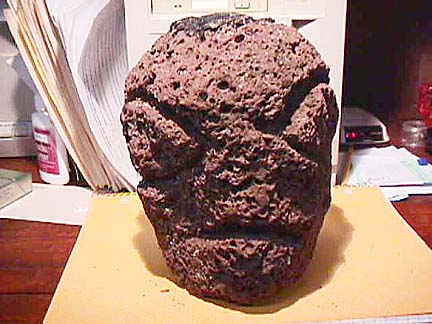Advertisement - Click to support our sponsors.

‘Aumakua’ at The stone looks pretty ominous.
auction ‘a fake’
or ‘right’?
An 8-inch-by-6-inch stone image
is on sale for $4,500 on eBay,
but an archaeologist
denies its authenticityeBay item No. 548427562
By Janine Tully
Star-BulletinIt features a mean-looking face with protruding eyes and pitted exterior -- not exactly your everyday friendly tiki sculpture.
But the approximately 8-inch-by-6-inch stone image is selling for $4,500 on eBay's auction block.
The seller, antique collector Brad Adams of Kailua, describes the stone on the Web site as an ancient aumakua, or Hawaiian family god.
Not so, says archaeologist Sara Collins with the state Historic Preservation Division, who saw the image on the Internet.
"It is a fake; it looks recent," Collins said. "The style of carving is not like any of the authenticated aumakua figures made of basalt, a denser type of stone."
Collins said that the stone is "kind of neat, but modern, and should not be represented as a very old, authentic art."
Buyers interested in Hawaiiana may not care whether the stone is really ancient or not, as long as it looks, well, different. So far, the stone has not been attracting many takers. As of Tuesday, there were only two $500 bids.

"An item is only worth what someone is willing to pay for it in a given day," Adams said. And based on appraisals of similar objects, $4,500 seems just about right to him.The origin of the stone remains as nebulous as its authenticity. As Adams tells it, a young construction man stopped by his store, Windward Antiques, a few months after Hurricane Iniki, with the stone under his arm and asked him if he wanted to buy "one big stone with a hole in the head and on the bottom."
Adams said he believes the 1-inch hole on top of the head was probably used to burn kukui nut oil for illumination.
Bulldozers clearing beach-front property unearthed the stone, along with poi pounders and ulu maika (small stones used in a game), he said.
At first, Adams was skeptical about buying yet another aumakua. But when he took a closer look at the stone, he "almost died."
"It spoke to me," said Adams. It seemed to say, "Buy me, I'm real."
"When you're in this business long enough and you do your homework and you look at a lot of stuff, you start to get a feeling of when things are right. Everything spoke to me that this was right."
Adams paid the young man $100, knowing that the piece was probably worth more, he said. But as long as a person sets the price -- in this case the young man had asked for $100 -- a collector is not required to pay more, he said.
As to the stone's authenticity, all he can say is that based on his 30 years in the business, he thinks the stone is real. "Aumakua are one of the most difficult items to identify because normally they were personal items in a family," he said. "Every collector has a different opinion. That's what makes it fun."
Believing that an object might be ancient is not a problem, said Collins. The problem comes when items like Adams' aumakua are described as original ancient pieces. "Besides consumers being ripped off, we don't want to inflame the interest in the trade of artifacts," Collins said. "The state wants to discourage this type of activity."